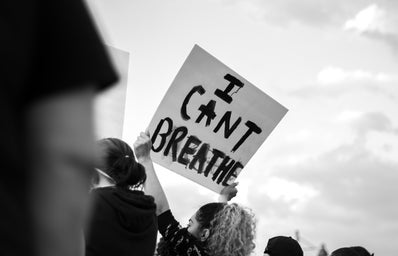TW: This article contains information about the ongoing George Floyd trial.
On May 25, 2020, George Floyd, a 46-year-old black man, went to the store to buy cigarettes. He was later arrested and pinned down by police officer Derek Chauvin for 9 minutes and 29 seconds. After being without oxygen for 10 minutes, Floyd died in police custody. His cries for help echo “I can’t breathe” and haunt us as we acknowledge the broken system that failed to protect his life.
His murder sparked an American uprising. Fear, anger and passion provoked protests and riots to ignite across the entire world. For once in all of United States history, Americans came together in all 50 states to protest in support of the Black Lives Matter movement.
After decades of injustice and racial inequality, Americans are putting their foot down and fighting back. George Floyd’s wrongful death changed life as we once knew it. America will never be the same.
Derek Chauvin’s trial for George Floyd’s death began on March 29, 2021, and is expected to last up until one month before the jury reaches a verdict.
The purpose of the trial is to decide if Chauvin should serve time in prison or be acquitted. Chauvin has pleaded not guilty to second-degree unintentional manslaughter, second-degree manslaughter and third-degree murder. Twelve jurors, plus two alternates, will remain anonymous throughout the entirety of the trial.
If found guilty, Chauvin could face up to 40 years in prison for second-degree murder, up to 25 years for third-degree murder, and up to 10 years for second-degree manslaughter. However, these are separate charges — meaning that Chauvin can be convicted of all, some or none of the charges.
Before the trial began, George Floyd’s family, along with Rev. Al Sharpton and attorney Benjamin Crump, kneeled outside of the courthouse for eight minutes and 46 seconds to highlight how long Floyd was crying out for help, helpless and unable to breathe as Chauvin’s knee suffocated his neck. However, it was discovered later on this day that Chauvin kneeled on Floyd’s neck for nine minutes and 29 seconds — an additional 43 seconds longer than the infamous time.
Minneapolis 911 dispatcher Jena Scurry claims that she saw Chauvin use excessive force while arresting Floyd.
Bystander and witness Donald Wynn Williams II testified that he watched Floyd gasping for air with his eyes rolling to the back of his head while blood came out of his nose.
Several other witnesses testify seeing George Floyd not resisting his arrest and the police officers using excessive force without stopping.
Video footage from bystanders and the bodycam footage captures the cries of spectators watching the violent arrest happen. Many witnesses begged for the police officers to stop or to check his pulse. However, the officers did not do so.
Paramedic Derek Smith testified that he didn’t see any chest rise or fall when he arrived at the scene of George Floyd’s arrest.
“In lay terms, I thought he was dead.”
Paramedic Seth Zachary Bravinder also testified that he could tell that Floyd was not breathing when he approached the scene.
On the ambulance ride to the hospital, Brovinder had to stop the ambulance to aid Floyd after he “flatlined.” He recalls that there was no blood pumping in Floyd’s heart at that time.
In a previously unreleased video, Derek Chauvin is heard speaking with his supervisor Sgt. David Pleoger about his perspective on the arrest.
“We just had to hold a guy down. He was going crazy. He wouldn’t… He wouldn’t go in the back of the squad,” Chauvin explains. “We had to control this guy because he’s a sizable guy. It looks like he’s probably on something.”
Defense attorney Eric Nelson argues that Chauvin’s use of force was authorized and part of police officer training.
“Derek Chauvin did exactly what he had been trained to do over the course of his 19-year career,” he contends. “The use of force is not attractive, but it is a necessary component of policing.”
However, Chauvin’s supervisor Pleoger testified that Chauvin’s use of force should have ended sooner.
“When Mr. Floyd was no longer offering up any resistance to the officers, they could have ended the restraint,” he states. “If you restrain somebody or leave them on their chest and stomach for too long, their breathing can become compromised, and so you’d want to get them up out of that position after a while, so they don’t suffer breathing complications.”
The Minneapolis Police Department’s top homicide detective Lt. Richard Zimmerman testified that Chauvin’s use of force was “totally unnecessary” and “uncalled for.”
“Once the person is cuffed, the threat level goes down all the way. How can that person hurt you?” he attested.
The trial will continue for the next few weeks. It is, without a doubt, a historical event. As it continues, it is important to stay updated on the events while distancing yourself if necessary.
The traumatic events of May 25, 2020 can be very triggering for many people. Resources are always available to support your mental health during times like these.
Though it has been almost a year without a verdict on George Floyd’s death, there is hope that the trial can bring justice to him and the several others who have been failed by the system and provoke change for the future.


